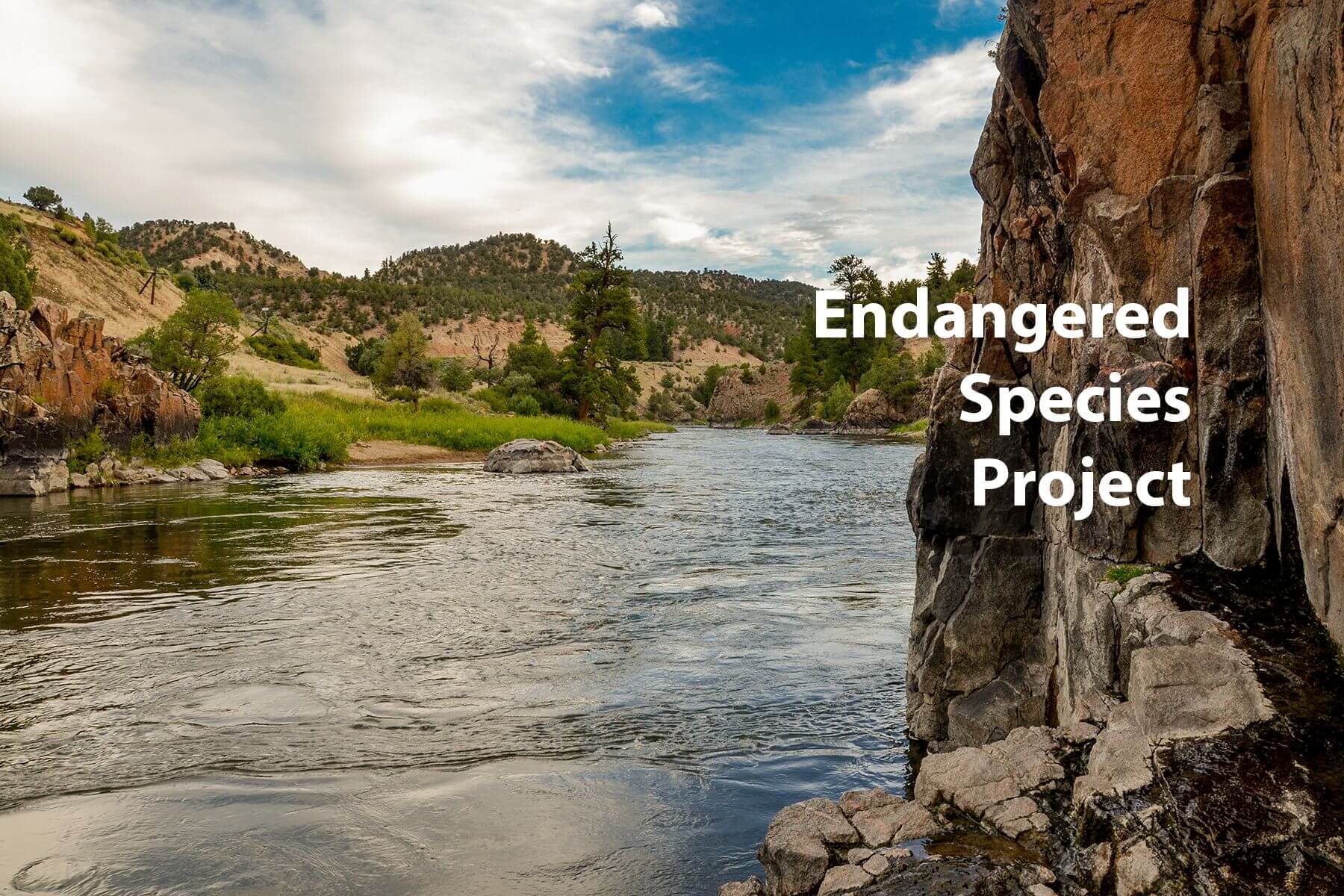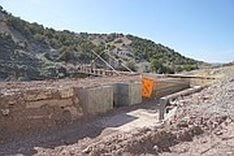Endangered Species

Upper Colorado River Endangered Fish Recovery Program
Watch a video of the 2017 Colorado Water Congress Annual Convention, where Tom Chart provides an update on the Upper Colorado River Endangered Fish Recovery Program:
Summary of the Upper Colorado River Endangered Species Fish Recovery Program
PROGRESS TOWARDS RECOVERY
- Razorback Sucker Recovery Plan/Species Status Assessment: The Program Director's office is revising the document. It is expected to be finalized this fall, 2017.
- Colorado Pikeminnow Population Viability Analysis: A Recovery Program consultant is conducting the analysis via a modeling process. Another draft report should be available in early October and completed this fall.
- Humpback Chub Species Status Assessment: The most recent draft is out for peer and Program review, with comments due by September 30. The document could be finalized in October.
COLORADO RIVER BASIN
- Grand Valley Power Plant Rehabilitation: The Department of the Interior has cleared the WaterSMART grant. The Bureau of Reclamation will review the plans. Construction should be underway in 2017.
- Coordinated Facilities Operations Report: A final draft of the report has been submitted to the Recovery Program and others for comment.
ELKHEAD RESERVOIR
- CPW conducted a fishing tournament at Elkhead reservoir. The objective was to remove smallmouth bass and northern pike from the reservoir. The tournament was successful! 332 anglers participated and 932 smallmouth bass and 395 northern pike were removed.
YAMPA RIVER
- Don Anderson, Instream Flow Coordinator, developed a paper describing operations of Elkhead Reservoir to augment flows in the lower Yampa River.
WHITE RIVER BASIN
- Hydrologic modeling is being conducted to assess various demand scenarios and means of meeting those demands. The modeling and analyses are precursors to development of a management plan that identifies future demands, flow recommendations for endangered fish, and the means of protecting those flows, and non-flow alternatives to benefit endangered fish.
PROGRESS TOWARDS RECOVERY
- Razorback Sucker Species Status Assessment: Tom Pitts has offered the Recovery Program staff to revise the razorback sucker species status assessment so that it may be used by USFWS to support the downlisting of the razorback sucker. Comments are now pending
- Colorado Pikeminnow Population Viability Analysis: Another draft of the analysis should be available August 31, 2017, and a final version should be available late September/early October pending review by the Recovery team. After completion of the analysis, a 5-year species status review will be submitted to the Service to determine the appropriate status of the species.
- Humpback Chub Species Status Assessment: The Recovery team will review the revised draft of the species status assessment due August 18. At that point, the document should be finalized, and Recovery Program staff will prepare a 5-year status review and submit it to the USFWS.
- Bonytail Status Review: There are no viable populations of bonytail in the upper basin or elsewhere. The Recovery Program has created "conservation group" to identify options for stocking bonytail and restoring populations. No change in status is expected, and a 5-year status review will be prepared during the Fall of 2017.
- Recovery Plans: The recovery plans for the 4 endangered species were last published in the 1990s. An update was published in 2002 that included elements of the recovery plans. The current plan is to update the recovery plans following final mid-2018 publication of the updates status of the species. The revised recovery plans would likely be published in early to mid-2019.
COLORADO RIVER BASIN
- Grand Valley Power Plant Rehabilitation: Mark Harris and the Grand Valley Water Users Association reported that the Recovery Program contribution was cleared by the Department of Interior. A decision is still pending on the WaterSmart grant from Reclamation.
YAMPA RIVER
- Jackie Brown, Tri-State, reported that the Yampa-White Roundtable had been looking at a higher base flows in the Yampa. AN option would be to contract for additional water from Elkhead. Discussions of a higher base flow by the Roundtable will continue.
WHITE RIVER
- The White River Management Planning Team reviewed various modeling efforts of Wilson Water Group involving analysis of historic flows, incorporation of various future demands/development alternatives into the model to develop flow recommendations for the White River. The flow recommendations could be finalized in late 2017. The management plan and PBO could be developed in 2018.
GREEN RIVER
- Flow Protection by State of Utah: Utah has completed modeling of "Full" and "Maximum Potential" future water development in the Green River basin in the context of Utah's remaining unused Colorado River allocation. Utah is still trying to reach a consensus on projected depletions. The proposed Lake Powell Pipeline project is still 'on the table.'
PROGRESS TOWARDS RECOVERY
- Razorback Sucker Species Status Assessment: Tom Pitts is editing the Report, and Tom Chart will write the long-term and short-term viability assessment for the species. The revised draft should be completed by August 15, 2017.
- Humpback Chub Species Status Assessment: Dr. Rich Valdez will develop the report with input from the recovery team. The next draft is due in early July. The Service will conduct a 5-year status review in a relatively short time and then proceed to prepare a downlisting package for the humpback chub.
- Colorado Pikeminnow Population Viability Analysis: The analysis is considered a prelude to the development of a species status assessment. A draft report should be available in July, 2017.
COLORADO RIVER BASIN
- Grand Valley Power Plant Rehabilitation: Mark Harris reported that it appears both the Reclamation WaterSMART grant and funding from the Recovery Program will be available to rehabilitate the Grand Valley Power Plant in the very near future.
- Coordinated Facilities Operations (CFOPS) Report: Tom Pitts has submitted a draft of the report to Recovery Program staff and received their comments. The report should be available in July, 2017.
YAMPA RIVER
- Recovery Program staff is developing a paper on flow recommendations.
PROGRESS TOWARDS RECOVERY
- Razorback Sucker Recovery Plan/Species Status Assessment: Comments outlined the numerous inconsistencies and deficiencies in the species status assessment and failure to comply with USFWS guidance on developing species status assessments. Some edits were made.
- Humpback Chub Species Status Assessment: The most recent revised draft of the species status assessment (provided in April 2017), is under review and comment.
- Colorado Pikeminnow Population Viability Analysis: The population viability analysis, due in September 2017, will be used to develop a species status assessment.
COLORADO RIVER BASIN
- Grand Valley Power Plant Rehabilitation: All grants and cooperative agreements will be implemented only after the review process is complete.
YAMPA RIVER
- The Maybell Ditch Irrigation improvements were completed on May 8th, 2017. The only remaining component is the satellite link that will allow remote operation of the automated gate. The improvements have made operations of the canal more efficient, have saved a lot of labor, and should increase flows in the lower Yampa.
WHITE RIVER
- The consultant has developed project water demands that may be applied in the White River plan and PBO.
PROGRESS TOWARDS RECOVERY
- Razorback Sucker Recovery Plan/Species Status Assessment: Discussions on the species status assessment continue. The focus includes the failure to provide a biological basis for the 30 and 100 year viability analysis, failure to provide a methodology for the viability analysis, and general failure to comply with USFWS guidance on development of species status assessment.
- Humpback Chub Species Status Assessment: The assessment is still in progress. A number of revisions are expected as a result of the Recovery Program's comments - in particular with the lack of biological basis for the long-term and short-term viability analysis.
- Colorado Pikeminnow Population Viability Analysis: Expected completion date is September, 2017 with a draft expected by mid-summer.
COLORADO RIVER BASIN
- Grand Valley Power Plant Rehabilitation: Funding for rehabilitation is expected. An analysis on the impact of the Power Plant shutdown on water deliveries to the 15-mile reach was reported. The analysis was sponsored by Grand Valley Water Users Association.
- Orchard Mesa Irrigation District Improvements: The improvements will provide at least 17,000 af of additional flow in the 15-mile reach and improve operations of the OMID system.
GREEN RIVER
- The Green River Canal Company recently raised an issue regarding the installation of the Tusher Wash fish screen to prevent the entrainment of endangered fish. The issues were resolved, and the fish barrier should be build in 2018.
YAMPA RIVER
- In an effort to resolve significant issues between the Yampa Division Engineer's office and the Maybell Irrigation District regarding administration of releases from Elkhead Reservoir for endangered fish, improvements are being made.

PROGRESS TOWARDS RECOVERY
- Razorback Sucker Recovery Plan/Species Status Assessment: The draft species status assessment is currently being developed to determine whether the United States Fish and Wildlife Service can either down-list or de-list the razorback sucker. The long-term timeframe addressed in the final draft, concludes that viability is 'uncertain' due to climate change and other factors. The assessment is in progress.
- Humpback Chub Species Status Assessment: The assessment serves the same purpose as the razorback sucker recovery status assessment: to either down-list or de-list the humpback chub. The draft assessment failed to follow the United States Fish and Wildlife Service guidance. Both the short-term and long-term species status assessment had no biological basis. The assessment is in progress.
- Colorado Pikeminnow Population Viability Analysis: The program staff decided to adopt a population viability analysis to establish the listing status of the Colorado pikeminnow.
COLORADO RIVER BASIN
- The rehabilitation and design process is proceeding on schedule. The Water and Energy Efficiency Grant should be approved. In such a case, funding would be adequate for the rehabilitation of the Grand Valley Power Plant. The power plant shut down is anticipated in November, 2017 for one year.
YAMPA RIVER
- The program seeks alternate solutions for the potential conflicts regarding the administration of releases from Elkhead Reservoir and the administration of the Maybell Irrigation District diversion. An alternate solution is the need for remote communication involving the installation of a satellite dish.
GREEN RIVER
- The Recovery Program is attempting to install the fish screen to prevent the entrainment of endangered fish. The turnover at the canal company is causing some delay that could cause an ESA compliance problem.
PROGRESS TOWARDS RECOVERY
- Razorback Sucker Species Assessment: The draft species status assessment expresses long-term viability in terms of a 30 to 100 year timeframe. This timeframe creates uncertainty regarding the future of the species based largely on speculation on the feasibility of climate change delisting the species. The assessment is in progress.
- Humpback Chub Species Assessment: The species status assessment is in the review process. It appears to be in a good condition, but still addresses long-term viability in terms of a 30 to 100 year timeframe.
COLORADO RIVER BASIN
- It appears that adequate funding will be available to rehabilitate the Grand Valley Power Plant. The process would begin in November 2017 and should be completed in November 2018. There is a need to evaluate flow management possibilities during the rehabilitation process.
WHITE RIVER
- Previous flow recommendations are being reviewed and revised as part of the development of the programmatic biological opinion for the White River basin.
